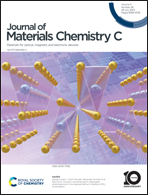3,5-Dicyanopyridine motifs for electron-transporting semiconductors: from design and synthesis to efficient organic light-emitting diodes†
Abstract
Proposing 3,5-dicyanopyridine motifs for the design of electroactive materials for optoelectronic devices, three electron-transporting semiconductors are synthesised. The compounds are characterised by high triplet energies of 2.68–2.79 eV, high glass-transition temperatures reaching 185 °C, ionisation potentials of ca. 6 eV and electron affinities of ca. 2.7–2.9 eV. Two compounds show deep-blue emissions caused by the relaxation of hybridised local and charge-transfer states. In contrast, another compound with the additional carbazole donor unit demonstrates pure charge-transfer emission. The compounds are characterised by different hosting properties causing very different efficiencies of thermally activated delayed fluorescence (TADF) of the emitter 4,6-di(9,9-dimethylacridan-10-yl)isophthalonitrile (DAcIPN). The different reverse intersystem crossing (RISC) rates and RISC activation energies of DAcIPN are in the ranges of 1 × 105–1.7 × 106 s−1 and 26–34 meV, respectively. An organic light-emitting diode based on the same TADF emitter and the newly synthesised host demonstrates a maximum external quantum efficiency of 21.9% which is considerably higher than that (12.9%) of devices based on the conventional host 3,3′-di(9H-carbazol-9-yl)-1,1′-biphenyl. Time-resolved electroluminescence study proves efficient emissive harvesting of triplets when a 3,5-dicyanopyridine-based host is used.



 Please wait while we load your content...
Please wait while we load your content...